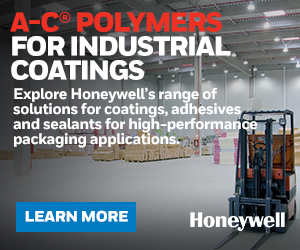
For more than thirty years, UV light has been a proven method for curing coatings used in flexible packaging, with many companies utilizing this technology for over two decades. However, the emergence of ultraviolet light-emitting diodes (UV-LEDs) represents a recent and important breakthrough in UV curing technology.
Working principles of UV-LED curing technology
UV-LED curing technology utilizes light-emitting diodes made of semiconductor materials to generate ultraviolet (UV) light by passing an electric current through them. When a forward bias voltage is applied, electrons recombine with electron holes within the device, producing photons as a result. The wavelength of the emitted photons is determined by the energy gap of the semiconductor material. By exposing a liquid LED coating to the light from the LED source, the coating’s components undergo polymerization, which causes the liquid to transform into a solid coating layer almost instantly.
Benefits and advantages of using UV-LED curing technology
While UV arc and medium-pressure lamps have been effective, they do have some limitations. These lamps consume a lot of energy, emit infrared (IR) heat, experience a decrease in intensity over time, are doped with heavy metals to alter the irradiance spectrum, and require a makeup air cooling system when used in large arrays, making them challenging to mount on various platforms. The use of ultraviolet mercury lamps as a radiation source has got environmental concerns from mercury and the generation of ozone as a by-product. Fortunately, UV-LEDs can help mitigate many of these issues.
Compared to UV mercury lamps used in curing applications, LED lamps offer several advantages. LED lamps do not rely on mercury to generate UV light and are typically smaller and more compact than mercury UV arc lamps. Additionally, LED lamps have an instant on/off capability, eliminating the need for warm-up time and contributing to their low energy consumption. LED lamps also generate less heat, have higher energy conversion efficiency, and longer lamp lifetimes. Furthermore, the choice of semiconductor materials employed in the LED allows for essentially monochromatic light emission at a desired wavelength.
Key considerations in designing UV-LED coating formulations
To develop a radiation-curable coating formulation, suitable for flexible packaging, it is important to evaluate the wavelength sensitivity of the photoinitiators (PI) in the coating. This is necessary to determine whether the selected LED light source will be able to activate the PIs and facilitate the curing process. Currently, UV-LED light sources typically emit light within the range of 300 to 475 nm, with 365 nm, 390 nm, and 395 nm being common peak spectral outputs. To achieve efficient and effective UV curing of a coating, the formulator aims to match the UV lamp output with the spectral absorption of the photoinitiator.
The concentration of PI in a typical UV formulation is usually less than 10%, and PIs usually absorb light across a range of wavelengths rather than a narrow band. While many existing UV formulations developed for curing with a typical mercury arc lamp use a broad-spectrum PI, this approach often results in much of the PI absorption range going to waste since only a portion of the absorption range overlaps with the UV-LED output range. To achieve a more efficient cure, it is possible to design a formulation specifically for UV-LED curing, utilizing a PI with concentrated absorption in the UV-A wavelength range.
Versatile applications of UV-LED coatings across flexible packaging industry
UV-LED coatings have numerous versatile applications across the flexible packaging industry. From providing over-coat coatings to enhancing print designs, these coatings offer a range of benefits that can help to improve the functionality and aesthetic appeal of flexible packaging materials. These coatings provide a glossy, matte, texture effect as well as a special effect finish to the packaging, making it more visually appealing. Additionally, these coatings can also be used to enhance the color and vibrancy of printed designs.
Yansefu’s UV-LED curing coatings offer a range of conventional and aesthetic benefits that make them ideal for a wide range of applications. These coatings deliver both high-gloss finishes and unique texture effects that enhance the appearance of surfaces while also providing superior durability and protection. These effects can also be used to create a variety of visual and tactile experiences, from a rough, gritty surface to a smooth, velvety finish. These textures can be customized to meet the needs of customers, making them ideal for a range of applications. With their quick cure times and environmental friendliness, these coatings are a smart choice for anyone looking to enhance the look and performance of their packaging products.
The UV-LED technology is continuously evolving and driving the demand for UV-cured materials, particularly UV-cured effect coatings. With the advancements in UV-LED equipment and concurrent improvements in UV-cured coating chemistry, the integration of UV-LED and UV-cured coatings has become a facilitating finishing technology. This technology not only replaces solvent coatings but also opens up many new opportunities for materials and product markets.









